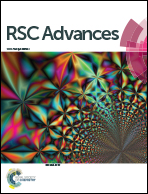High performance polydimethylsiloxane pervaporative membranes with hyperbranched polysiloxane as a crosslinker for separation of n-butanol from water†
Abstract
Hyperbranched polysiloxane (HPSiO) was successfully synthesized by a three-step process. The result of 29Si Nuclear Magnetic Resonance (NMR) measurement indicates that the degree of branching (DB) of HPSiO is 0.73. Then, novel polysiloxane membranes, HPSiO-c-PDMS, were prepared by the cross-linking reaction between HPSiO and α,ω-dihydroxypolydimethylsiloxane (H-PDMS) with different molecular weights. HPSiO-c-PDMS membranes were first used as membrane materials for recovering n-butanol from an aqueous solution by pervaporation (PV). The HPSiO-c-PDMS membranes demonstrated high n-butanol/water selectivity as well as high permeability. As the molecular weight of H-PDMS increased, the selectivity increased and the n-butanol permeability of HPSiO-c-PDMS-2 (with moderate H-PDMS molecular weight) membrane showed the highest value. The effects of temperature and feed concentration on the PV performances were also investigated. The PV performance, n-butanol permeability and n-butanol/water selectivity of the HPSiO-c-PDMS-2 membrane, reached 4.3 × 105 Barrer and 8.75, respectively, with a feed concentration of 1.0 wt% at 30 °C.


 Please wait while we load your content...
Please wait while we load your content...